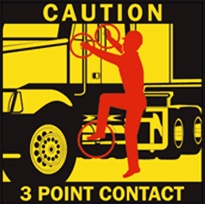Be Safe When Entering and Exiting Trucks with Three Points of Contact
Search the Library

According to a report a few years ago from the Occupational Safety and Health Administration, truck drivers had more non-fatal injuries than any other industry. More than half of those were sprains and strains caused in part by slip and falls while getting in or out of trucks.
To reduce or prevent such injuries, your WorkSafe team recommends using the “three points of contact system” when entering and exiting a truck. The three points of contact system means three of four limbs are in contact with the vehicle at all times (two hands and one foot, or two feet and one hand, etc.).
 “Three-points of contact form a triangle of anchor points, which changes in form when mounting or dismounting a vehicle,” says Accident Fund WorkSafe Manager of Technical Services David Hintz. “Drivers have the most stability when the center of the triangle is closest to their center of gravity. Sideways movement should be avoided since it creates an imbalance of weight distribution.”
“Three-points of contact form a triangle of anchor points, which changes in form when mounting or dismounting a vehicle,” says Accident Fund WorkSafe Manager of Technical Services David Hintz. “Drivers have the most stability when the center of the triangle is closest to their center of gravity. Sideways movement should be avoided since it creates an imbalance of weight distribution.”
Here are some helpful tips for entering and exiting a truck:
- Always use the three point of contact system.
- Mount and dismount only when the equipment is stopped.
- Don’t ever jump off a truck — landing exerts 12 times your body weight on your joints.
- Take extra care in wet, snowy or icy weather.
- Don’t carry items in your free hand — place them on the vehicle floor and retrieve them once you’re on the ground.
- Don’t use tires or wheel hubs as a step surface.
- Never use the door frame or door edge as a handhold.
Preventing injuries on the job requires education, demonstration and continuous training to reinforce proper techniques and habits. Training should begin when a driver is hired and be reinforced frequently. To further promote safety, all trucks should display warnings in the cab or on the door to remind workers to use the three points of contact system.
Want to know more?
If you’re an Accident Fund policyholder, log onto our policyholder site by clicking here, and check out our WorkSafe Toolbox™ and other available safety tools. If you’re not a customer, click here for additional safety information. Or click here to find an Accident Fund agent near you!
Share this resource:
URL coppied to clipboard.
Or send it directly to someone via our email form:
